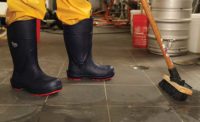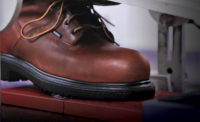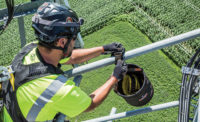It’s important to evaluate COF to determine footwear’s slip resistance

Designing safety footwear that reduces the risk of slips, trips and falls should be a key objective for footwear manufacturers. At the time of this writing, no U.S. government agency mandates performance specifications, nor is there any industry consensus defining slip resistance for PPE footwear in the US. That’s astonishing when one considers that OSHA states that slips, trips, and falls constitute the majority of general industry accidents, cause 15 percent of all accidental deaths, and are second only to motor vehicle accidents as a cause of fatalities. Because there are so many factors that affect slips, trips, and falls, a major area of developmental focus for manufacturers is to assess the coefficient of friction (COF) for footwear under laboratory settings for several different conditions.
Determining a COF
To be clear, a coefficient of friction is not technically the same as slip resistance, although the terms are frequently used interchangeably. Slip resistance is defined in ASTM (American Society for Testing and Materials) F1646, a terminology standard, as “the relative force that resists the tendency of the shoe or foot to slide along the walkway surface.”
A COF, on the other hand, is the ratio of the frictional force between two bodies and the force pressing them together. At the risk of oversimplification, a COF can be calculated under controlled laboratory conditions; slip resistance involves a complex interplay of factors including the walkway surface conditions and pitch, the footwear tread pattern, the walking gait of the individual, and the presence of foreign materials on the floor surface, to name a few. The focus on coefficients of friction to assess slip resistance stems from the fact that the COF and the force required to slide an object are directly proportional -- the greater the COF the greater the resistance to sliding.
Determining a COF means calculating the ratio of the frictional force between two objects and the force pressing them together. Coefficients of friction can be determined for either static or dynamic friction. Static coefficients of friction are a measure of how much force is required to move a stationary object; dynamic or kinetic coefficients of friction are a measure of how much force is required to keep a sliding object sliding. Because most slips occur during walking, a key factor in designing slip-resistant footwear is testing that can accurately measure the dynamic COF under a variety of conditions.
The historical lack of a performance specification establishing a minimum COF for footwear has not been due to the inability to calculate a COF or for lack of trying, given that the ASTM has introduced (and then withdrawn) test methods that attempted to standardize the process and ensure reproducibility. Rather the problem has been the inability to assess a dynamic COF, accurately and precisely, with repeatability from one laboratory to another.
2011 ASTM standard
In 2011 the ASTM published F2913-11, Standard Test Method for Measuring the Coefficient of Friction for Evaluation of Slip Performance of Footwear and Test Surfaces/Flooring Using a Whole Shoe Tester. It is the latest standard test method on this topic and provides an excellent means of assessing dynamic coefficients of friction, and by extension, for ultimately producing slip resistant footwear.
Unlike prior methodologies, ASTM F2913-11 determines the dynamic COF between footwear and floor contaminants under reproducible laboratory conditions. It is applicable to all types of footwear, to most types of indoor floorings, and it allows testing of various flooring surface contaminants. Plus, the testing must involve three separate modes to determine the dynamic COF in three specific areas that attempt to mimic a walking gait. The three modes are:
- Forward Heel Slip: Assess the COF at the critical “heal strike” of the gait
- Forward Flat Slip: Assess the COF at the midstance of the gait
- Backward Slip on the Forepart: Assesses the COF at the “toe off” of the gait
Clear direction
The science of producing slip-resistant footwear continues to advance with new materials and innovative outsole tread patterns. A defined, reproducible test method of assessing the dynamic coefficient of friction for the whole shoe under a variety of conditions and in modes that simulate a walking gait exists in ASTM F2913-11. Future steps in the right direction would be to recognize the ASTM F2913 standard test method in the establishment of minimum coefficient of friction values for defined conditions and the incorporation of those COF minimums into an ASTM standard performance specification for safety footwear. Such actions would establish a clear direction for manufacturers to assess the use of materials and designs to give consumers the highest probability of avoiding costly slip and fall injuries.
Looking for a reprint of this article?
From high-res PDFs to custom plaques, order your copy today!





